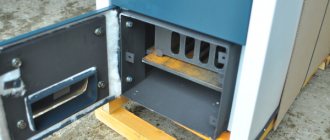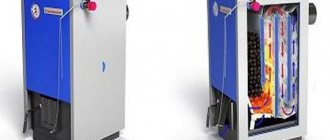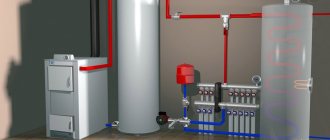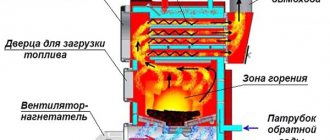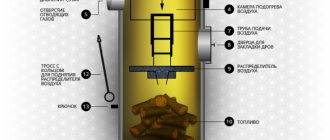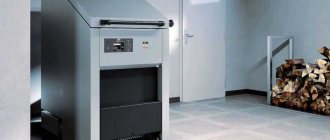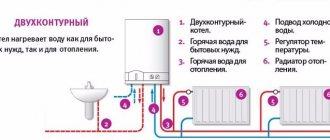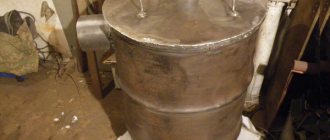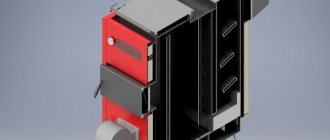Installing a solid fuel boiler is the first step towards efficiently and economically maintaining heat in the house. The next steps are to regularly add firewood or other types of solid fuel. It is also necessary to maintain the temperature of the heating system coolant within operating limits at night. And even when the house is visited only on weekends, maintaining a minimum temperature is required to avoid moisture condensation on the internal surfaces of the room.
If the presence of condensation is not critical, then when leaving after the weekend, you need to wait until the boiler stops and drain the water from the heating system to avoid freezing of the system. If water is drained, all metal elements corrode upon contact with air.
There is no need to drain the coolant if antifreeze is used instead of water. However, when using antifreeze, due to its high fluidity, high demands are placed on threaded seals and shut-off valves.
The most common solution for maintaining the temperature in the heating circuit is to install an electric boiler together with a solid fuel one. The minimum amount of additional equipment will allow the electric boiler to automatically take over the heating functions, and the solid fuel boiler to turn off, without the risk of boiling. Also, the use of an electric boiler eliminates the need to carry out any manipulations with the heating system, leaving the country house until the next weekend. To monitor emergency situations and remote control of the electric boiler, there is a GSM module that controls the operating mode of the heating equipment.
Types of electric boilers
When choosing an electric boiler for installation in addition to a solid fuel one, it is enough to quickly familiarize yourself with the basics of heating water using electric current, so as not to get caught in the network of marketers. Electric boilers operate with an efficiency of about 95%. You should not use your heating system to check the veracity of the manufacturer’s assurances about the incomparably high efficiency of their devices - this may cost extra money, and it will not pay off soon. There are three main types of boilers:
1. Heating element boilers.
Heating in them is carried out by an electric heating element (heating element), which is immersed directly in the coolant. Both water and antifreeze can circulate in the circuit of such a boiler. It is unpretentious in operation, but periodically requires replacement of the heating element due to the formation of scale, which reduces heat transfer.
2. Electrode boilers.
The coolant in them is water. Heating occurs due to the energy released when electric current flows through the coolant in the boiler between the electrodes that are located inside. Can work without an electric pump in the circuit. Provides smooth heating of water in the system. Over time, as a result of electrolytic reactions, the electrodes dissolve and require replacement.
Functions of an electric boiler in a heating system with a solid fuel unit
Connecting an electric boiler to the system together with a solid fuel heating device is a fairly common engineering solution. This option eliminates the possibility of the heating system cooling down, prevents overcooling of the main heating unit and maintains a comfortable temperature in the house. An electric boiler often acts as a backup heating device, the task of which is to equalize the temperature of the coolant in the heating system.
Layout of solid fuel and electric boilers when used together in a heating system
The operation of solid fuel boilers requires periodic human supervision - all models of such units require fuel loading.
Note: for traditional boilers, the number of loads can reach up to 2-6 times per day. The situation is different with pyrolysis boilers and long-burning units. Frequent human intervention is not required here. One load of fuel is enough for 12-24 hours of boiler operation, and for some models - for 48 hours of operation.
The main task for the home owner when the heating is on is to prevent the boiler and heating system from cooling down. An electric boiler paired with a solid fuel boiler successfully solves this problem. Let us consider in detail the combination of a solid fuel boiler with a heating device powered by electricity.
The working scheme is as follows: a solid fuel unit with a power of 50 kW must be combined with an electric boiler whose power is 28 kW. The operation of the electric heating device is periodic. The unit must be on standby - ready to be turned on immediately after the main equipment is stopped. The electric boiler starts when the fuel in the solid fuel boiler runs out and the temperature of the coolant in the system drops to 50 0C. In this case, the circuit must have a water tank for the hot water supply system, which in this case acts as a heat accumulator.
The main circuit elements that consume the power of autonomous heating boilers are:
- heating radiators - require 30 kW;
- heating system "warm floor" - up to 15 kW;
- storage capacity for the hot water system - on average 300 liters.
Attention! Automation for adjusting the switching of circuits in this situation - a bunch of units is not required.
An electric boiler, working together with a heat accumulator, is a group that prevents coolant with a temperature that has fallen below a critical level of 50 0C from entering the main heating unit.
The pump installed in the system periodically circulates the coolant through the pipeline, signaling the temperature in the heating circuit. When the coolant temperature drops to a critical level, an electric boiler equipped with heating elements comes into operation, taking on the task of heating the house. A thermostat and three-way valve control the temperature of the hot water tank. When the water temperature in the DHW system circuit decreases, the coolant enters the coil to heat hot water. A correctly connected electric boiler and proper connection with a solid fuel boiler will make your system fully controllable.
In the described design of the heating system, all heating equipment, including the pipeline, when the main heating device is stopped, is reliably protected from defrosting and does not cause interruptions in heating of residential premises and hot water supply.
Features of the purchase and installation of electric boilers
When installing electric heating equipment, a number of nuances should be taken into account:
- In order to properly connect the electric boiler to the electricity and heating system, it is necessary to resort to the services of employees of organizations engaged in this type of work on a professional basis.
- The device itself should be purchased from specialized retail outlets, where the relevant documents are attached to it. The equipment must have original packaging, which should preferably be opened in the presence of a specialist from the service department. Together with it, the boiler is inspected to ensure that there are no mechanical damage or other defects on the surface.
- Before installing the electric boiler, you need to remove the plugs from the pipes and make sure that there is no dirt in them and the communications. With this electric boiler connection scheme, sealing materials and gaskets are used.
- When choosing a place to install a thermal electric boiler, it is advisable to give preference to non-residential premises. The best option is the kitchen (see photo). The device should be positioned so that it is convenient not only to use, but also to carry out its maintenance. In accordance with the standards, the gap between the sides of the boiler and the walls should be 5 centimeters. The free space in front of the appliance cannot be less than 70 centimeters, above it - at least 80 centimeters, and below the boiler - at least 50 centimeters.
- Heating equipment must be installed on a wall made of non-combustible material. To install the device, use a special fastening element - a mounting plate. Usually it is included in the basic package of an electric boiler. The plank is secured to the wall using 4 dowels.
Completion of the heating system installation
At the stage when the connection of the electric boiler to the heating system and electrical network is completed, perform the following actions:
- check the serviceability of the pipeline fittings located in front of the device. To do this, it is switched from the “closed” to “open” position and back;
- The pipeline fittings of a heat generator powered by electricity are moved to the “closed” position. In the same mode, the fittings of water supply and heating systems should be installed;
- On the pipelines supplying cold water to the heating boiler, it is necessary to open the shut-off valves. When using an electric heating system, do not use non-freezing coolant fluids, as they will negatively affect the functioning of the equipment. They contain components that over time lead to wear of the rubber elements. For the heating system, water with a minimum hardness level should be used;
- before entering the device on the return pipeline, it is necessary to install a sump filter or a filter or both of these parts;
- After filling the heating system with coolant, you need to check its tightness.
Connecting an electric boiler to a TT boiler
If it is necessary to provide heat supply to a country house, experts believe that the most reliable and profitable way is to connect an electric boiler to a solid fuel boiler. A device operating, for example, on wood will be a backup non-volatile heat source.
Most often, the electric + solid fuel boiler design is installed in houses with an area of 100 to 200 square meters, when there is no main gas pipeline in the locality. The main thing is that the necessary electrical power is supplied to the building.
This page shows connection diagrams for a solid fuel boiler along with various equipment: an electric boiler, an indirect heating boiler, a heat accumulator, a gravity circuit, etc.
Features of using solid fuel boilers
The basis for heating a house with a unit that runs on wood, coal, or peat is an increase in the temperature of the liquid in the main due to the process of burning the energy carrier. The water, heating up, moves through pipes to heat exchangers in the rooms.
Devices have been developed that use pellets as fuel, which are small granules made from wood waste.
Types of equipment
There are several types of solid fuel devices for heating rooms.
They differ in:
- type of energy carrier and method of its supply;
- number of circuits;
- power level and heat transfer;
- the presence of a hob;
- dimensions.
Solid fuel equipment has only a floor mounting option. To supply a residential building with DHW, units with 2 circuits are selected. If you plan to use the boiler for cooking, then you need to buy a model with a hob.
Pyrolysis and gas generator devices are designed for heating. To operate these devices, solid fuel is used, from which flammable gases are released and enter the combustion chamber.
Such boilers have the following advantages:
- ease of adjusting the heating power;
- high efficiency;
- almost complete combustion of the energy carrier.
The presence of a blower fan in the device reduces the requirements for the chimney.
The disadvantage of the equipment is the need to use only dry fuel. This forces the home owner to ensure that the energy is stored in a place where it will not become damp.
The price of pyrolysis and gas generator units is higher compared to classic models of solid fuel units. It makes sense to purchase equipment if you need to heat large areas. The device pays for itself due to the economical use of energy.
Choice of material
Solid fuel units can be manufactured using different heat exchangers. This structural element is made of cast iron or steel.
If you plan to independently service the device, then the best choice would be boilers with cast iron coils installed. This material is less demanding on operating conditions and is not subject to corrosion, but it has several disadvantages.
Among them:
- high price;
- sensitivity to temperature changes.
Cast iron boilers are not particularly demanding to clean and slightly reduce efficiency when carbon deposits form.
Devices with steel coils are more resistant to temperature changes due to the plasticity of the material. In addition, the mass of the heat exchanger in such a boiler is less, which speeds up the heating of the liquid.
Advantages and disadvantages
Advantages of using the equipment:
- autonomy - does not depend on the presence of voltage in the electrical network;
- no additional energy consumption;
- ease of maintenance;
- fuel availability;
- safety.
Disadvantages of the devices:
- The need for regular energy loading. Depending on the size of the device, this is done from 2 to 5 times a day.
- For normal operation of the boiler, it is necessary to install a chimney with good draft for combustion and complete combustion of fuel.
- The water in the system must be constantly warm, this is necessary to prevent the formation of carbon deposits on structural elements.
- When loading energy carriers, smoke may be released into the room.
- The need to regularly clean the combustion area from accumulations of ash and soot.
- During operation, it is difficult to control heat generation.
Schemes: TT boiler
This is the simplest wiring diagram for a solid fuel boiler. It can only be used if a boiler control unit is used, which provides control of the circulation pump to prevent condensation.
This is a common budget piping scheme for a solid fuel boiler. It includes protection against condensation formation - a three-way valve. Read more.
Wiring diagram for a solid fuel boiler with an emergency gravity circuit. Of the existing safety elements, the emergency gravity circuit is the most reliable, in my opinion. Read more.
This diagram shows the piping of a wood-burning boiler with a four-way emergency mixing valve. I do not recommend it for boilers with a cast iron heat exchanger.
With this type of piping, you additionally need to install a heating element into the boiler.
This option is for boilers with a fan. A separate pump is installed on the boiler. An automatic system is required with a function to control the boiler pump, with a function to turn off the pumps when the temperature drops below the condensation point. A heating element is also installed in the boiler.
Connection diagrams
Connecting two different types of boilers in one thermal circuit is a very important step. Any even minor mistake, except for the ineffective operation of heating equipment, can create an emergency situation in the house.
The calculation of a two-boiler connection diagram should be entrusted to the design organization so that they can select the most optimal pair of units with parallel or series piping and control options: automatic or manual.
Automatic boilers
From a hydraulic point of view, this scheme does not differ much from the manual control principle, only 2 check valves are installed in it.
This is required in order to eliminate “parasitic” or idle coolant flows through the boiler unit, which is in reserve. This problem is also solved by installing a hydraulic arrow. Check valves are installed on the return line, directed towards each other.
This system will also require a thermostat that turns off the pump for forced circulation. When the coal burns out in the boiler, there will be no point in circulating idle water through the stopped device, thereby creating resistance to the operation of the second device.
Connection diagram for 2 manually controlled boilers
In this option, to ensure consistency in the operation of the boiler units, only shut-off and control valves are needed. All operational switching between units is performed by the operator’s hands by opening/closing 2 valves on the return coolant line. To completely stop the flow of hot water, you will need to turn off the 4th valves, respectively, in pairs on the supply and return.
In such schemes, I provide expansion tanks to compensate for the thermal expansion of water when heating the boiler from a cold state. In order to save money, it is not recommended to leave one tank, since it may not cope with the load when two boilers are operating.
Series and parallel connection
These are two generally accepted schemes for piping two boilers operating in pairs.
Sequential, involves sequential switching on of units without additional lines and nodes. In this case, the first unit in the direction of water movement heats it, and the second unit heats it to the required temperature.
The parallel scheme involves the arrangement of two points of connection of flows on forward and reverse coolants. In this option, the boilers operate independently of each other.
Sequential circuit
The first option is used for small heating sources. In practice, it is quite rare and is considered impractical, since it is impossible to remove one unit for repair operations without affecting the functionality of the other.
Such a scheme will be inoperative if even one unit malfunctions. Today, this scheme has been partially modernized through the installation of bypass lines and additional shut-off and control valves.
Parallel connection of different types of boiler units in a single system is considered advantageous and allows the installation of a hydraulic switch and an automatic control unit.
Parallel connection
Schemes: TT boiler + Electric boiler
In this diagram there is no unit for maintaining the return temperature of the solid fuel boiler. This is possible if the electric boiler works all the time and maintains the temperature in the heating system. Or, if the TT boiler is equipped with automation that controls the pump to prevent condensation.
Scheme of piping a TT boiler with a simple electric boiler. The use of such an electric boiler significantly reduces the cost. Read more.
TT boiler + electric boiler + indirect heating boiler. Trim option with flow redirection valve.
In this diagram there is no unit for maintaining the return temperature of the solid fuel boiler. This is possible if the electric boiler works all the time and maintains the temperature in the heating system.
TT boiler + electric boiler + indirect heating boiler. Strapping option with hydraulic arrow.
The most flexible option that allows you to solve any problems using automation.
Electric boiler with solid fuel boiler: simplified diagram
As usual, let's start with a general diagram to give a general idea:
In this scheme, each boiler can operate either independently or simultaneously with the second.
In the diagram, the electric boiler is the simplest: without built-in automation and without a circulation pump, but the actual tank with welded pipes and heating elements inside. Therefore, in the diagram the pump is outside. Maybe you'll buy a different model, something like this:
It's all-inclusive, all that remains is to connect the pipes. Well, supply and return valves in front of the boiler are required.
